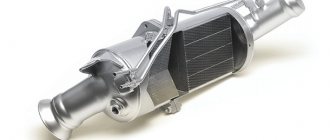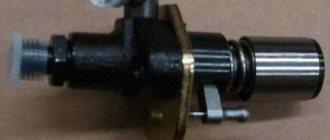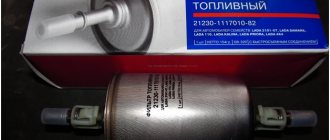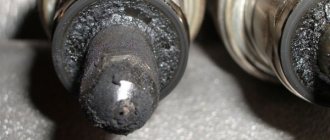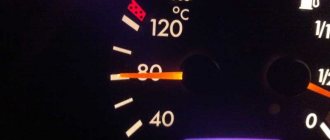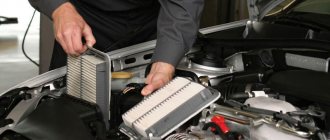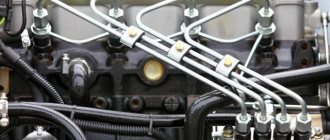Modern diesel cars have many design solutions for cleaning engine exhaust gases. These include the EGR exhaust gas recirculation system, and one of the solutions is the widespread installation of DPF particulate filters. During active use, such a filter can quickly fail under certain conditions.
The main task of the filter element is to trap soot. The next step is to burn out the accumulated soot deposits in such a way as to minimize damage to the environment. At the very beginning, the filter collects soot up to a certain point. This moment is determined by the difference in pressure before and after the element. When the pressure deviates from the permissible limit and the filter capacity does not allow further efficient passage of exhaust gases, the diesel engine ECU activates the appropriate mode to burn out the accumulated soot.
We also recommend reading the article about which diesel engine can be installed on the popular domestic SUV Niva (Lada 4×4). From this article you can find out which diesel units are installed on this model as an alternative to replacing the standard gasoline engine.
Afterburning of soot on a diesel engine is turned on under various conditions, which are individually set by the manufacturer of a particular model. These conditions are summarized by the fact that the diesel engine must have a medium or high crankshaft speed and be in motion. The ECU gives a command to increase the amount of fuel at the time of injection. The result is an increase in the temperature of the exhaust gases at the outlet. With such an increase in temperature, the soot burns out. If the car is operated in an urban area with short trips at low speeds, constantly warms up in winter and sits idle for a long time in traffic jams, then the self-cleaning mode of the diesel particulate filter is simply not activated. Constant exposure to such conditions leads to rapid clogging of the element.
Soot actively accumulates and clogs the filter element. After the throughput is reduced by 9/10, the resistance to the exhaust gases will lead to a loss of power and difficult starting of the diesel engine. This malfunction, which is associated with actual blockage of the exhaust system, can affect both new cars and those with high mileage.
The service life of the particulate filter directly depends on a number of factors and the individual operating conditions of the vehicle. A critically clogged element needs to be replaced. It is worth noting that the cost of a high-quality new part is quite high. For this reason, the question of how to clean the diesel particulate filter has become acute.
Why does the particulate filter become clogged?
The pollution process begins as a result of the combustion of diesel fuel in the cylinders of a diesel engine. A by-product of combustion of a mixture of diesel fuel and air is soot. This soot does not cause any particular harm to the filter, since it is a fine powder. During filtration, these particles are simply retained on the mesh.
The problem arises due to the presence of hydrocarbon particles in the exhaust that were not burned in the working chamber. Hydrocarbons lead to the active formation of tar deposits. Soot microparticles are literally glued together with resin, resulting in accelerated formation of carbon deposits. Carbon deposits also contain components of diesel engine oil in the form of metal sulfates, which are formed after combustion of the oil that has entered the cylinders.
Sulfates appear in the exhaust due to the fact that metal-containing additives are included in the basic composition of the additive package for diesel oils. This especially applies to universal motor oils, which can be used equally for both diesel and gasoline internal combustion engines. The result is that the diesel self-cleaning system is unable to remove dense deposits on the particulate filter.
Benefits of regular maintenance, cleaning and rinsing
The service life of the diesel particulate filter directly depends on the total number of self-cleaning cycles initiated by the ECU.
The more often a part self-cleans, the more platinum catalyst burns out under the influence of elevated temperature. The main advantage of constant maintenance of a diesel exhaust system is the economic aspect, as well as the ability to operate the engine with consistently optimal performance. If a diesel internal combustion engine is in conditions that lead to increased carbon formation, then preventative cleaning of the particulate filter is much more profitable than driving without servicing it until replacement. This is clearly expressed in financial terms. A serviceable diesel engine with a cleaned filter always delivers full power, consumes fuel moderately, starts easily, does not harm the environment, and the reliability and overall life of the internal combustion engine are increased.
It is advisable to additionally clean the element at each scheduled maintenance, after troubleshooting problems with fuel equipment or repairing the engine itself. In a word, cleaning is required both for prevention and after eliminating the causes of prolonged malfunctions in the diesel engine, which lead to the formation of soot on the soot filter mesh.
Additionally, you can extend the “life” of the part by using special additives in diesel fuel. Such additives make it possible to improve a number of parameters during diesel operation. A separate group of additives is aimed at making the carbon formation process less intense, and is also aimed at reducing the total amount and lowering the temperature during the automatic self-cleaning of the cleaning element.
The diesel additive helps diesel fuel burn fully in the cylinders, which reduces the amount of soot in engine exhaust gases. When self-cleaning, there is no need to heat the diesel catalyst for a long time; in this case, catalyst burnout becomes less intense. If the engine is in good condition, good quality diesel fuel is poured in, and the additive is regularly used once every 2-3 thousand kilometers, then additional filter cleaning may not be required at all.
Operating techniques
To effectively use a diesel engine, the price of which is quite high (about 900 euros), it is necessary to operate the car correctly. The thing is that during the process of cleaning exhaust gases, the cells and tubes become clogged with soot. This leads to a decrease in the efficiency of the diesel engine.
The throughput of the filter decreases and the resistance to the exit of exhaust gases increases. Many manufacturers, in order to increase the service life of this stock without the need for frequent replacement, have used a special filter operation algorithm when the filling level is controlled. If the filter is so full that engine power is lost, filter regeneration is triggered.
Cleaning methods
The widespread problem has forced leading companies to develop ways to clean, prevent and protect diesel particulate filters. There are two main approaches to increase the efficiency of regeneration of a diesel filter element:
- cleaning the diesel particulate filter without removing it;
- washing the diesel particulate filter with removal;
It is also necessary to know exactly how to wash the specified element of the exhaust system of a diesel engine, since the use of cleaning products not intended for this purpose can completely disable the contaminated element.
Passive regeneration method
This cleaning can be carried out directly by the car enthusiast. The corresponding indicator will indicate the need for regeneration. It is also necessary to start this process if the dynamics or power of the engine decreases.
The most important thing is to ensure an increase in temperature for the exhaust gases. This is done by driving the car with a full load. It is enough to drive 30-40 km for the filter to be completely cleaned and all the soot to burn out. The second option is the use of special fuel additives.
Do-it-yourself diesel particulate filter cleaning
Let's start with a method that involves removing the particulate filter. This washing procedure usually requires about 8 hours. After completing the dismantling of the filter element and removing it from the machine, the housing is completely filled with a special flushing liquid for cleaning. Such liquids for washing particulate filters are widely available on sale. The leaders on the market are the products of Liqui Moly, Luffe, PRO-TEC.
Liquids are made from petroleum components and are often packaged in 5-liter cans. The average consumption for high-quality washing of one particulate filter is at least 4 liters of the composition. Moreover, the canister may have a special neck in advance, since you will then need to connect a hose. Canister options are also available, equipped with a ready-made hose.
The principle of operation of the washing liquid is based on the fact that the composition effectively dissolves the resins (kept for about 8 hours), on which the formed carbon deposits are held. It is necessary to carefully follow the requirements of the fluid manufacturer, since it is very important to wait the necessary time for the full effect of washing on the soot.
Next, the released soot is simply washed off with a regular stream of clean water under pressure, which is applied to the filter. After this, the filter is dried and put in place. The resin solvent itself is petroleum-based, can be easily washed with water, and does not pose any harm to the catalyst structure.
Washing with removal allows the use of only special liquids that affect resins at the molecular level. The use of other means is strictly prohibited, as the matrix inside the filter has a fragile platinum layer. After washing, the cleaning effect is monitored visually. Often this method ensures complete and most effective cleaning of the filtration element.
Washing on a car without removing the filter
The second method is to wash the particulate filter without removing it, which means carrying out the work directly on the car. The filter part of a diesel car is equipped with pressure and/or temperature sensors. If you unscrew the sensor, then it becomes possible to supply flushing fluid.
Since washing is carried out on a car, manufacturers take into account the possible risk of fire of the washing composition. In such conditions, it is no longer possible to use petroleum products. For cleaning, water-alkaline solutions paired with washing liquid are recommended. This liquid will neutralize harmful alkali after the solution has completed the cleaning process. Liquid is supplied to the element body using a gun specially designed for this purpose. A straight or curved probe is also used, and a spray nozzle is additionally provided.
A set of liquids, a gun, sprayers and probes allow you to work with almost any model of diesel car equipped with a particulate filter. Cleaning using this method involves a step-by-step dosed supply of the cleaner through the sensor hole. The most commonly used installation location is the pressure sensor, which is located in front of the element. The car is warmed up in advance, then the filter is allowed to cool to approximately 40 degrees Celsius. The fact is that alkaline cleaning composition is most effective at this temperature.
For cleaning, you will need about 1 liter of liquid, which is left in the element body for 15 minutes. The high pressure spray gun is connected to a straight or curved probe, which is inserted into the sensor hole. The cleaner is sprayed intermittently (up to 10 seconds spray, up to 10 seconds pause) directly onto the surface of the particulate filter. The operating pressure when spraying should be approximately 8 bar. It is advisable to rotate the probe during the spraying process, as well as move it back and forth to achieve better quality of application of the cleaning liquid to the filter element matrix.
We also recommend reading the article about why a diesel engine can smoke blue or gray exhaust. From this article you will learn why a diesel engine may be so smoky in various operating modes.
Next, a rinse aid is sprayed in the same way, which neutralizes and washes away the cleaner. You will need about 500 ml. cleaning composition. Washing occurs using the same spray gun; similar pause time intervals are observed between spray stages. Thanks to this approach, the soot is distributed over the surface of the matrix more evenly. The result will be that the soot can be burned much more efficiently during the automatic self-cleaning process.
Upon completion, the pressure sensor is installed back in place, the diesel engine starts and warms up. After this, you will need to start the self-cleaning mode in order to burn through the soot particles freed from the bonding resins. This can be done either “naturally” or forcefully. In the first case, you will need to actively operate the diesel engine on the move for about 20 minutes at medium and high speeds so that the electronic engine control unit independently initiates the start of the particulate filter regeneration process.
If this is not possible or the automatic start of self-cleaning does not occur due to malfunctions in the diesel electronics, then the mode is forced to be activated. This is done using a diagnostic scanner. Diagnostic equipment will also allow you to evaluate the quality of cleaning the particulate filter from carbon deposits. To do this, you need to compare the element's throughput readings before and after using flushing.
Active regeneration
This mode can be started automatically by the ECU controller. To do this, the electronics analyzes information from the temperature sensor and pressure sensor. It informs the electronic control unit that the filter is clogged, and the sensor reports the temperature. If it is not enough for the soot to burn completely, the ECU can additionally inject fuel during the exhaust gas release process. This will burn off the soot in the exhaust. This also allows you to raise the temperature to the desired level.
If there is other equipment in the exhaust tract that also increases heating, the ECU can use them too.
Quick self-cleaning
Today, there is also the option of packaging flushing liquids in aerosol cans, which eliminates the need to use a spray gun. Additionally, the need to spray a wash-rinse aid may be eliminated, which depends on the specific manufacturer of the liquid and the composition of the proposed cleaner.
Using such solutions is extremely simple, which can be appreciated by using the example of washing a particulate filter without removing the filter element from Pro-Tec. The DPF Catalyst Cleaner product is a 400ml can of foaming particulate filter cleaner that also comes with a flexible wand. This amount is enough to completely clean one element, regardless of the degree of contamination. The product can be used to clean particulate filters of any generation.
- Before use, the can must be shaken for at least one minute;
- Next, the pressure sensor is removed, providing access through the hole;
- Then the diesel engine is warmed up a little and then the engine is turned off;
- The next step is to insert the probe and spray the cleaning agent;
- You do not need to spray the cleaner immediately, but in several approaches (5 seconds spray, 5 seconds pause);
- The procedure continues until foam appears visible in the sensor hole;
- Afterwards, the spray probe must be removed, replacing the removed sensor;
Before starting the diesel engine for the first time after cleaning, the manufacturer also recommends adding an additive to the diesel fuel called Super Clean. The composition is poured directly into the car’s fuel tank in accordance with the dosage indicated on the packaging. As you can see, additional washing of the filter itself after cleaning is not required.
